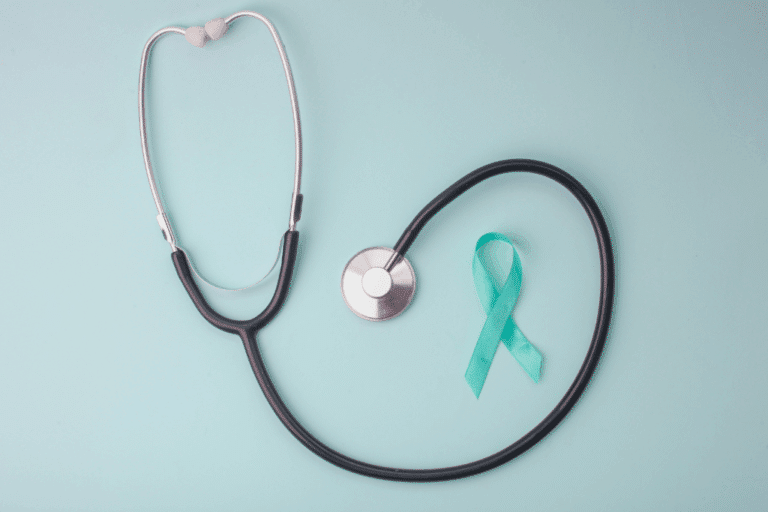Estrogen dominance.
It’s a condition that gets a big ol’ shrug from many in the medical community, but for a lot of women, it’s a real and disruptive problem.
Estrogen dominance happens when estrogen is high relative to progesterone. And here’s the kicker: this can occur even if both hormone levels are technically “normal.” (Spoiler alert: those “normal” lab ranges are WIDE. Like, laughably wide.)
What really matters is the ratio between estrogen and progesterone. An optimal ratio is somewhere between 100 and 500. Anything below 100? That’s where estrogen starts throwing a party… and not the fun kind.
First, a Quick Hormone Refresher
Estrogen 101
Estrogen isn’t just one hormone—it’s actually a group of three:
- Estrone (E1) – a weaker form, most prominent after menopause
- Estradiol (E2) – the most potent and active form during reproductive years
- Estriol (E3) – rises in pregnancy and plays a protective role
Estrogen is mainly produced in the ovaries, but also comes from the adrenal glands and even fat tissue (which becomes important later—stay with me).
Estrogens are multitaskers: they regulate your menstrual cycle, support bone and brain health, keep your cardiovascular system humming, and even play a role in immunity and how we age.
Progesterone 101
Progesterone is your chill-out hormone. It balances estrogen, supports sleep and mood, stabilizes blood sugar, helps build bones, and yes, it’s also key in pregnancy. It’s what tells your uterine lining, “Time to calm down now.”
During a normal cycle, progesterone spikes after ovulation. But if ovulation doesn’t happen (as is common in perimenopause), progesterone takes a nosedive, leaving estrogen in the driver’s seat.
Can Estrogen Dominance Happen in Menopause?
Absolutely. In fact, many women are surprised to hear that even in menopause, estrogen dominance can rear its ugly head.
Here’s how it works:
Both estrogen and progesterone decline as you transition through menopause, but progesterone tends to fall faster and farther. That leaves you with a relative excess of estrogen, even if your absolute estrogen levels are lower than in your younger years.
This is especially true if you have:
- More body fat (since fat produces estrogen)
- Poor estrogen detox (your liver isn’t clearing it efficiently)
- Chronic stress (which suppresses progesterone via elevated cortisol)
This kind of estrogen dominance can lead to:
- Weight gain (especially belly fat)
- Sleep trouble
- Mood swings
- Brain fog
- Fibroids, heavy bleeding (if you’re still cycling), or postmenopausal bleeding
So no, estrogen dominance isn’t just a perimenopause issue. It can persist (or emerge) during menopause—especially if you’re not ovulating, are under stress, or have impaired detox pathways.
Classic Signs of Estrogen Dominance
Whether you’re in perimenopause or menopause, symptoms can include:
- Mood swings or anxiety
- Low libido
- Sluggish energy
- Trouble sleeping
- Hair loss
- Weight gain, especially around the middle
- Irregular or heavy periods (in perimenopause)
- Fibrocystic breasts, ovarian cysts, or fibroids
How Do We Fix It?
There’s no one-size-fits-all plan, but here’s where we always start:
1. Support Your Liver
Your liver is your estrogen-processing powerhouse. If it’s sluggish, estrogen metabolites get recycled into your system instead of being excreted.
- Eat clean
- Up your bitter greens (arugula, dandelion, mustard greens)
- Stay hydrated
- Avoid alcohol and toxic personal care products
2. Eat Brassica Veggies
These contain Indole-3-Carbinol (I3C), a compound that helps convert estrogen into safer metabolites (like 2-OH) while reducing the more aggressive ones (like 16-OH).
Add:
- Broccoli
- Cauliflower
- Kale
- Cabbage
- Bok choy
- Brussels sprouts
Bonus: they’re also full of fiber to keep your bowels moving—and your estrogens moving out.
3. Manage Stress
High cortisol robs you of progesterone and increases inflammation. Try:
- Meditation or breathwork
- Walking outside
- Saying “no” more often (seriously)
4. Choose Clean Protein
Poor-quality meats can introduce estrogen-mimicking compounds and inflammatory fats into your body.
Choose:
- Grass-fed, pasture-raised meats
- Hormone- and antibiotic-free poultry
5. Ditch Hormone-Disrupting Chemicals
Time for a household scavenger hunt! Some common products mimic estrogen or interfere with detox. Watch out for:
- Parabens
- Phthalates
- BPA (use glass over plastic)
- Aluminum salts (often in antiperspirants)
- UV chemical sunscreens
6. Lose Excess Weight (If You Can)
I know. I know. “Easier said than done, Dr. Anna.” Trust me—I get it. But fat tissue produces estrogen, so the more you can support fat loss (once your hormones are balanced), the better off you’ll be. Start small. Start with the steps above. This isn’t about willpower—it’s about physiology.
Testing for Estrogen Dominance
You don’t have to guess.
Testing methods include:
- Urine (DUTCH) – my go-to for a full hormone picture
- Saliva – useful for diurnal patterns (like cortisol)
- Blood – widely available, but doesn’t show metabolites
I look at not just how much estrogen you have, but how your body is using it. That’s the magic sauce.
The Bottom Line
Estrogen dominance isn’t a myth, and it doesn’t disappear just because your period does. If you’re feeling off, bloated, moody, or just not yourself, your hormone ratios could be the reason.
Let’s get you back in balance.
I’ve created a supplement protocol to help with estrogen dominance. You can access that here.
Want more help?
👉 Book your hormone consultation here: www.drannagarrett.com/lets-talk
👉 Curious about hormone testing and custom plans? Visit www.drannagarrett.com/hormone-harmony
You don’t have to figure this out alone. That’s what I’m here for.
Dr. Anna Garrett is a menopause expert and Doctor of Pharmacy. She helps women who are struggling with symptoms of perimenopause and menopause find natural hormone balancing solutions so they can rock their mojo through midlife and beyond. Dr. Anna is the author of Perimenopause: The Savvy Sister’s Guide to Hormone Harmony. Order your copy at www.perimenopausebook.com.
Dr. Anna is available for 1-1 consultation. Find out more at www.drannagarrett.com/lets-talk




